14 Fun Facts About the Port of Milwaukee
Everything you wanted to know about the city’s most entrepreneurial department.
Milwaukee’s often overlooked position as an international port was dramatized this summer by appearance of the “Lugano” – the mysterious bulk carrier ship from Basel, Switzerland that lingered in the lake just outside the port for many days, drawing attention from the media. The port itself remains something of a mystery, a part of Milwaukee’s city government that gets little discussion. What does it do? How does it function? We’ve boiled down the answer to 14 things you probably don’t know about the port:
1. It handles 2.4 million tons of cargo
To be precise, in 2014 the Port of Milwaukee handled 2,402,622 metric tons of cargo. It’s a lot either way.
2. It’s an international port serving ocean-going vessels
Of approximately 200 ships that visited the port in 2014, one quarter were ocean-going vessels from foreign countries that made the trek through the St. Lawrence Seaway to Milwaukee. The remaining 155 or so were American and Canadian “lakers” – freight ships that travel solely on the Great Lakes.
3. It’s the last stop for Mississippi River barges
The Port of Milwaukee is the northernmost point on the Great Lakes to which Mississippi River barges are allowed to travel, and hosted 23 barges in 2014. “If you want to go down through Chicago, and ultimately go down the Mississippi and to the Gulf (of Mexico), either Alabama, or Houston, or New Orleans, the U.S. Coast Guard has to approve barge traffic,” says Port of Milwaukee Director Paul Vornholt, “You have to have what’s called safe harbor… There has to be a pathway that a barge – in inclement weather, or big waves – needs to be able to pull in and harbor between destinations. And Milwaukee is the last point – there’s nothing north of us that gives safe harbor. You can’t barge to Green Bay; you can’t barge to Manitowoc.” So anyone in eastern Wisconsin wanting to run a barge down the Mississippi must use the Port of Milwaukee.
4. It’s a money maker for the city
The port was a favorite city department of former Mayor John Norquist, because it returned money to the taxpayers. Its net revenue has risen steadily in recent years, from about $350,000 in 2008 to more than $1.4 million in 2013.
5. It’s a magnet for salt
More then 2 million tons of salt are shipped into the port each year. Much of that has traditionally come from the Great Lakes region, which is rich in salt mines, most notably in Goderich, Ontario and in Cleveland, Ohio. But in the wake of the polar vortex, the salt mines were unable to keep up with the winter demand, and local salt users banded together to organize shipments of international salt to Milwaukee. In a rather surreal scene, three ships arrived at the Port of Milwaukee in December 2014 carrying salt from Egypt, Morocco, and Venezuela.
6. It’s a magnet for steel.
“Last year, we brought in 180,00 tons of steel,” says Vornholt. “Our steel comes in bulk, uncut, in various forms… grades, and coils, and different types of products. Then it goes out to warehouses. Then it’s customized and shipped directly by order to companies that are making things.” That ultimately supplies many of the manufacturers in southeastern Wisconsin.
7. It handles huge piles of other cargo.
Besides salt, bulk cargo transported to and from the Port of Milwaukee includes piles of coal, wheat and other grains, limestone, and cement.
8. It helps supply mines across the world.
One of the main cargoes routinely shipped out of the Port of Milwaukee are components of massive mining shovels built locally by Caterpillar (formerly Bucyrus) and Joy Global (P&H). These companies supply much of the mining equipment used across the globe.
9. It handles liquid cargo
The Port of Milwaukee has a designated liquid cargo pier on the outer harbor. Liquid cargo can be transported to and from Milwaukee by boat, and stored on port property if needs be. In a new wrinkle, U.S. Oil, headquartered in Appleton, is building a new pipeline connection to that pier in anticipation of a potential upsurge in transportation of oil by ship. Says Vornholt: “U.S. Oil operates out of the port of Green Bay, which was at capacity, and was looking for another port. They looked at Chicago, they looked at Detroit, and ultimately chose Milwaukee. They chose this location to be strategically located in case Bakken crude ever wanted to go to the East Coast. So they could rail it in, put it on a vessel, and go out.”
10. It can offer far cheaper transit than transport by land.
Vornholt estimates it would cost $2 million more to transport the salt it annually receives if the salt arrived by truck or rail. Most of that salt goes to the City of Milwaukee, other municipalities and the State of Wisconsin, so all that savings is passed on to taxpayers.
11. It’s a foreign trade zone.
The Port of Milwaukee is a federal Foreign Trade Zone, a status granted by the U.S. Department of Commerce. This means raw materials and equipment can be shipped into the port from anywhere abroad, assembled at factories in 12 counties in southeastern Wisconsin, and shipped out for sale on foreign markets without any of the normal import/export duties and customs charges. “It’s meant to reward American factories and businesses to do the assembly and keep the jobs here, without penalizing them on the customs borders,” Vornholt notes.
12. It has minimal competition with other Great Lakes ports.
“We compete minimally with the Port of Chicago, but because of Chicago traffic, we typically win if it’s (being shipped from) O’Hare or north, and they typically win if it’s O’Hare or south,” Vornholt explains. “Our real competition is the other modes of transit: rail, and truck.” But the Port also loses out to East Coast and Gulf Coast ports because the St. Lawrence Seaway has size limitations, “meaning you can’t take ocean container-type vessels,” Vornholt adds. “If it’s larger, they might want to use an East Coast or a Gulf port.”
13. It lowers costs for all area businesses.
Even a business that’s never used the Port of Milwaukee saves money on transportation because of the Port’s impact. “If the Port of Milwaukee wasn’t here, and shipping and barging wasn’t an option, rail and highway would adjust accordingly,” Vornholt notes. The added traffic would mean increased demand for rail and truck transport and they would raise their prices. “From a competitive standpoint, we help businesses, even if they don’t ship.”
14. It is a landlord with 21 different tenants.
The Port of Milwaukee owns two sections of land. On the northern tract sit the Summerfest grounds, Discovery World, and the pier for the Dennis Sullivan sailing ship. The southern tract includes Milwaukee’s port, the Coast Guard station – which is in charge of maritime security for all of Lake Michigan, and the Lake Express ferry terminal, which shuttles passengers between Milwaukee and Muskegon, Michigan several times each day. The Port of Milwaukee’s 21 tenants include:
- Cargill Salt, Inc.
- Compass Minerals
- Discovery World at Pier Wisconsin
- Federal Marine Terminals, Inc.
- Great Lakes Towing
- Harbor House Restaurant
- LaFarge Corporation
- Kinder Morgan Bulk Terminals
- Kinder Morgan Transload
- Lake Express High-Speed Ferry
- Michels Corporation
- Milwaukee Art Museum
- Milwaukee World Festival (Summerfest)
- Portland Trucking
- South Harbor Terminals
- St. Mary’s Cement
- U.S. Coast Guard
- U.S. Navy
- U.S. Oil
- Walsh Construction
- Ward’s Welding


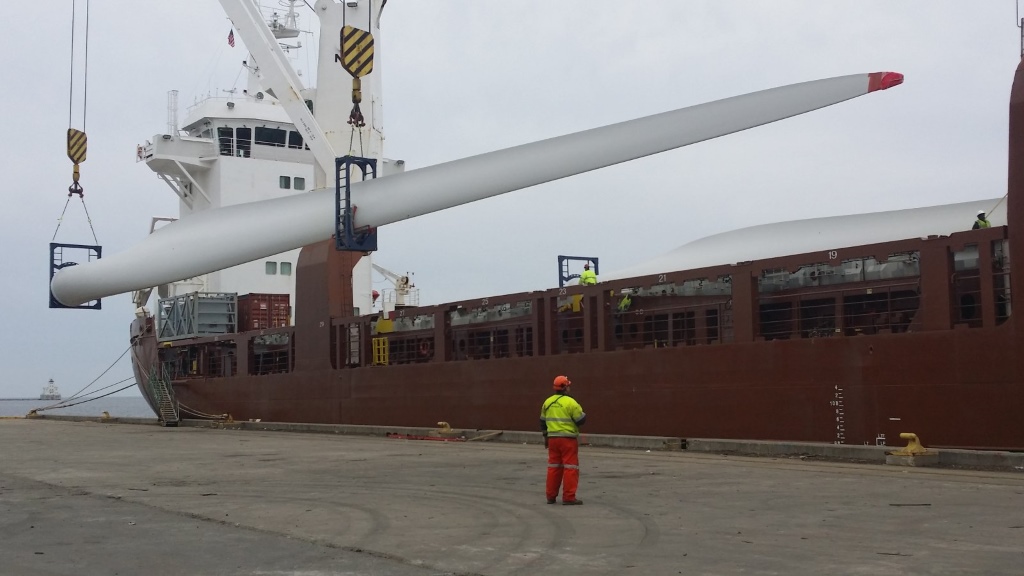
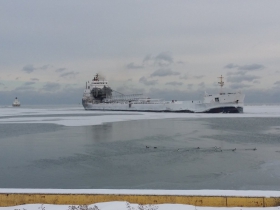
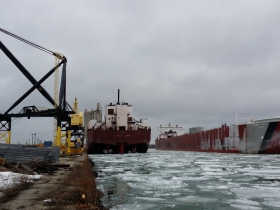
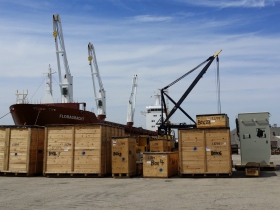
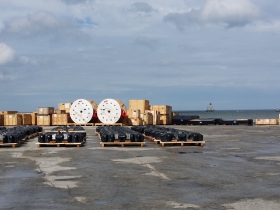
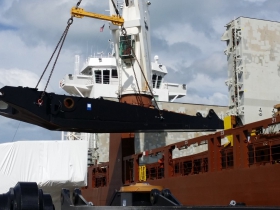
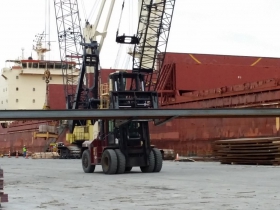




















How can a ship come from Switzerland? I’m sure it can have a swiss flag, but no way it sailed from Basel 🙂
Good question, but actually the Swiss have ports accessible on the Rhine. A ship can actually sail from Basel to Milwaukee! That really is a fun fact!
Your second point is a bit wrong, Lakers are typically larger than Salties, the ocean going ships. The only international ships on the Great Lakes are ones that can fit through the Welland Canal and they have to be under 740 feet long. Lakers are 700-1,000 feet long and a much wider than Salties.
You mention that Lakers are smaller ships, which is only sometimes true. There are a number of Lakers that are larger than the “Salties” that travel into the Great Lakes. They are too large to fit through the St. Lawrence Seaway and essentially stuck in the Great Lakes, and they are the largest ships you’ll see on the lakes.
In your first point, 2,402,622 metric tons is nearly 5.3 billion pounds, not 4.8 billion. A metric ton is 1,000 kilograms or about 2,205 pounds.
What a great post! I would love if our port was covered better. I have so many questions.
So…12 counties are in a foreign trade zone. Which counties are those?
@Casey W: Here’s more information about the Foreign Trade Zone. http://city.milwaukee.gov/Directory/Port/FOREIGN-TRADE-ZONE-NO.-41-GRAN1.htm#.VdUkREJViko I had so much more information that I couldn’t include in this article, but basically, the Foreign Trade Zone includes all of southeastern Wisconsin – from Kenosha County west to Rock County, north to Fond Du Lac County, east to Sheboygan county, and all the counties in between. You’re right about the size of lakers – I think the “small” comment was something that came up in editing. I think the point is that ocean-going vessels are often bigger than lakers, but only the ones that are small enough to fit through the St. Lawrence Seaway end up here. So it just depends on a ship-by-ship basis, whether certain lakers or “salties” will be bigger.
@Tyrell: The Lugano ship’s official home port is Basel, which is on a river. Through websites including http://www.marinetraffic.com and http://www.vesselfinder.com, it’s possible to track the movements of ships around the world. According to vesselfinder.com, the Lugano bulk carrier ship went from Fredericia, Denmark (April 15) to Kalundborg, Denmark (April 24), then from there to Milwaukee (May 25), then to Port Weller, Canada (June 6), then to Hartlepool, United Kingdom (June 26). Apparently it is currently in New Orleans. So while it’s difficult to say if the ship actually docks in Basel, it shows how international ships that visit the Port of Milwaukee can be.
Good!
Casey. The Port is the Grantee (Administrators) of FTZ #41. We took that status over in 2011. The 12 counties covered under the “expedited approval process” are Milwaukee, Racine, Kenosha, Walworth, Rock, Jefferson, Waukesha, Ozaukee, Washington, Dodge, Sheboygan, and Fond du Lac. Any company outside these counties but within the borders of Wisconsin can still apply for FTZ status through our FTZ#41, but that process may take longer. Nick G on our staff is always available to answer any FTZ questions you may have. 414-286-8133.
Thanks for the interesting article Laura. Even Wisconsin Conservative Digest couldn’t find fault with it!
Duluth has a narrow canal and lift bridge in the downtown area, through which the lake boats come and go, that is a major tourist attraction. There is a hotel on the canal, the South Shore Inn, that will call your room to let you know that a lake boat is coming or going. There is also a boat watch service that lets you know the lake boat schedule daily. Does the Port of Milwaukee have any kind of service like that for “boat watchers?” Is there a prime spot for “boat watching” in Milwaukee?
This stuff really is fascinating… and would indeed be cool to see a ship come or go. Betty, related to Frank’s question, are there areas in the inner or outer Harbor that are accessible to the public if they wanted to watch these sort of activities?
View ships in the inner harbor at the east end of Greenfield Avenue. Off 1st and Greenfield head east to the inner harbor. The ships in the outer harbor are a little tougher to watch, although off of Erie Street where the red light house is is a great spot to see them come and go.
Rather SE Wisconsin-focused on point #3. Anyone wanting to run a barge down the Mississippi can also use ports in La Crosse and Prairie du Chien, and there are a number of private barge facilities (such as for power plants) up and down the Mississippi River in Wisconsin.
Great photos and fascinating facts!
AG- when we lived in Bayview my daughter and I would ride our bikes down S Lincoln Memorial Drive which puts us right under the Hoan. In general wondering around Jones Island can actually be pretty cool and great views of the ships in the inner harbor. Be sure to stop at Kaszubes County Park the smallest park in the Milwaukee County system.
@DTY: Barges can indeed travel further north on the river systems, to the twin cities for example. But Milwaukee is the northernmost point on Lake Michigan that barges are allowed to go because of “safe harbor” rules.
The NY Times recently had an article about “scofflaw” ships (pirate ships, sort of) which touched on how the flags of landlocked countries (like Mongolia or Bolivia) end up on ocean-going ships.
Basically, a ship on the high seas can only be stopped by law enforcement or the military of the same country. If you fly a Bolivian flag, for example, you can only be stopped by the Bolivian navy (which doesn’t exist) or by the Bolivian police (which have no ocean-going vessels). The choice of which flag to fly is mostly economic (the countries with the lowest taxes and fees and least regulation get the most boats).
http://www.nytimes.com/2015/07/19/world/stowaway-crime-scofflaw-ship.html
I saw an example of this on my only cruise (in 1982) which was on Holland America’s “Volendam”. The cruise from NYC to Bermuda and back was for all intents American—the only language onboard was English, the only currency accepted onboard was US dollars, and every passenger we met was American. But the ship’s officers were Dutch, the crew was Indonesian, and the ship was registered in (flew the flag of) the Netherlands Antilles. The bottom line is that a ship’s official “nationality” means little and I wonder how much of this “Swiss” boat actually had anything to do with Switzerland.
Laura – I’m not disputing that Milwaukee is the northernmost point for Mississippi River barges on the Great Lakes. I’m disputing your statement that “… anyone in Wisconsin wanting to run a barge down the Mississippi must use the Port of Milwaukee.” Since the Mississippi River makes up much of Wisconsin’s western border, there are several ports directly on the Mississippi so one doesn’t haven’t to use Milwaukee. It is an option.
I reside in Green Bay and have run a comparison in that Green Bay and Milwaukee have extremely close port statistics, yet differ greatly in population. Green Bay port 2014 statistics; 2,307,346 metric tons from 191 ships. Milwaukee port 2014 statistics; 2,402,622 metric tons of cargo from approximately 200 ships.
sorry forgot to add a link to my post #20;
http://portofgreenbay.com/ship-activity/cargo-quantities-shipped
@Joel – Interesting. When I interviewed Vornholt, he said the main difference between the Port of Milwaukee and the Port of Green Bay is the draft. He said, “I never compare myself to Green Bay just because of the draft. We don’t compete right there, because you have to go into the bay of Green Bay, and all their terminals are on the river. So their draft is around 17 whereas we’re seaway vessel draft, meaning 23.”
DTY, you raise a fair point, we did correct text to say Eastern Wisconsin.
As one who has written extensively on longshoring at the Port of Milwaukee at http://www.zonyx.net/TEXTS/Sacks-Vi.html, I appreciate your article, but point out that the schooner you mention based there is properly spelled in the Irish manner, with one “n” as Denis:
http://www.schoonerdenissullivan.org/
What an interesting piece! I love learning so much by reading an informative article such as this. Well done. And, the number of constructive comments this generated says a lot. Amazed at the amount of conversations this generated. Usually, the comments are heavily laden with grammar or spelling critics. This author addressed all points very well. Kudos